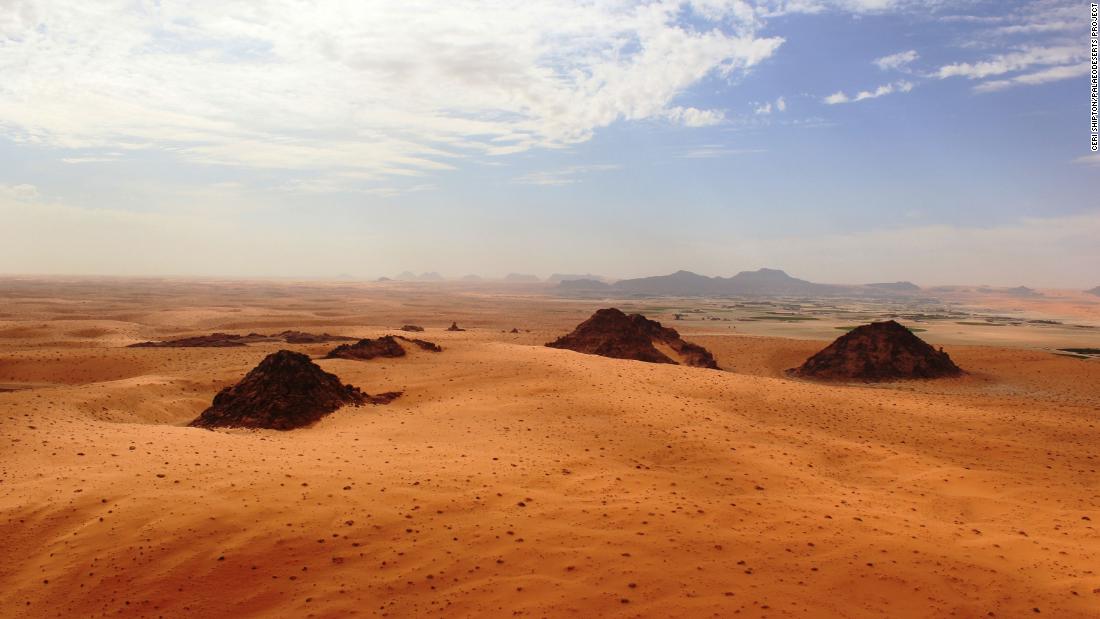
This is the oldest dated evidence for humans in Arabia, which includes Saudi Arabia and other countries on the Arabian Peninsula.
The deserts of Saudi Arabia are some of the driest regions in the world, but it was a different story hundreds of thousands of years ago. Environmental changes occurred after periods of heavy rainfall in the desert, which created lush prairies that served as the perfect backdrop for the first human ancestors to migrate to and from Africa.
In the gaps between large dunes, researchers found evidence of ancient lake formation at the Khall Amayshan 4 archaeological site and the Jubbah oasis in the Nefud Desert, located in northern Saudi Arabia. Between 400,000 and 55,000 years ago, these periodic lakes were formed and filled at five different times that were associated with the discovery of stone tools.
Stone tools help document how these early human cultures and their materials changed over time. The oldest tools belong to cultures that depended on hands, such as the first human ancestors Homo erectus and Homo heidelbergensis. This leads to a more developed technology of stone tools that could have belonged to the early Homo sapiens and Neanderthals.
The research is a “breakthrough in Arab archeology,” according to the study’s lead author, Huw Groucutt, head of the Max Planck Extreme Events Research Group in Jena, Germany, based at the Max Planck Institute. of Chemical Ecology.
“Arabia has long been seen as an empty place throughout the past,” Groucutt said. “Our work shows that we still know so little about human evolution in vast areas of the world and highlights the fact that there are still many surprises.”
Exploring “Green Arabia”
Gaps between sand dunes in the Nefud Desert would capture and agglutinate water during the “pulses” of heavy rainfall thousands of years ago, creating small lakes, wetlands and rivers bordered by grasslands. This environment supported the migration of both animals and early human ancestors.
The Arabian Peninsula in southwest Asia is the only land bridge connecting Africa with Eurasia. Although this area has been of interest to researchers, the deep, arid interior of the peninsula is not easy to access.
“To penetrate deep into the desert we need to have enough jeeps and supplies to carry out our prospecting and excavations, and from time to time we need to use a helicopter to get to the archaeological sites inside the deserts,” he said. the co-author of the study, Michael Petraglia, project leader and professor at the Max Planck Institute for the Science of Human History, by email.
Satellite images allowed researchers to see that there were once about 10,000 ancient lakes across Arabia, and when examining the archaeological sites, stone tools and animal fossils were found.
Massive wild cattle, ostriches, gazelles and even hippos lived on the shores of the lakes and were surrounded by meadows and savannas. “The presence of hippos is extraordinary, as this tells us that there were enough rivers, lakes and wetlands to maintain them,” Petraglia said.
“These‘ Green Arabia ’events attracted the animals and hominins that chased them,” he said. “However, the green events were not long-lasting, as they were followed by declining rainfall and desert formation. We don’t know what happened to the hominins during these arid periods, but we suspect they continued or they became extinct “.
The findings have suggested that human migrations walked through the heart of Arabia, rather than taking coastal routes as previous research suggests.
A place to meet
The recovered stone tools also illuminate the people who made them, even if their remains can no longer be found in the desert. And these tools tell a diverse story of cultures that join migratory routes.
“Arabia is the starting point for migrations between Africa and Asia,” Petraglia said. “It is the geographical bridge between continents that scientists have ignored for decades. It is clearly a key region for the migrations of various species of hominins (early human ancestors) over time, probably from different directions, including northern ‘Africa, the Levant and possibly other parts of Asia.’
It is possible that Arabia also served as a place for the interaction of different human species. Some of the tools dating back 55,000 years are similar to those made by Neanderthals, which would make this the southernmost discovery of Neanderthals to date.
“Arabia can be one of the most important places to understand where humans mix and mate,” Petraglia said. It is potentially the stage for cross-species interbreeding. We have to find human fossils to prove it and so the search continues. “
“It also serves to remind us of the profound ways in which environmental change has affected and continues to affect the survival of life on our planet,” said study co-author Tom White, a senior conservative non-insect invertebrate in history. natural. Museum of London, in a statement.
Now, researchers want to fill the remaining gaps in history of how ancient humans ended up migrating around the world.
“We know that archaic humans arrived in China 2.1 million years ago,” Petraglia said. “This means that we lack an archaeological record in Arabia and that there is a current gap of more than 1.5 million years.”
The oldest sites in Arabia could answer this question: scientists only have to identify them first.